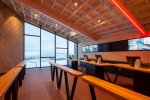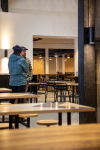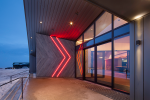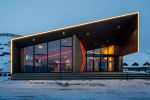Cardrona Alpine Resort Skifield Entry And Ticket Office
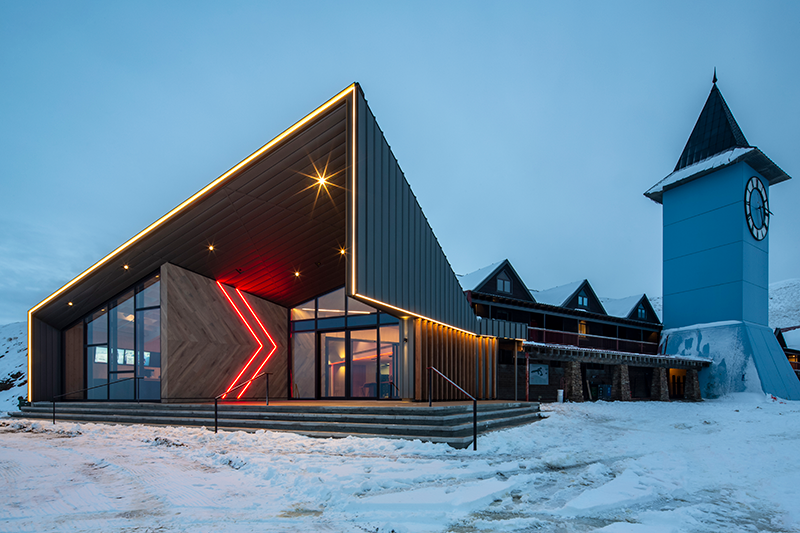
A new entrance and ticket office at Cardrona Skifield is the latest development in a masterplan to improve the visitor experience.
Architects Warren and Mahoney have been involved for many years in the rejuvenation and refinement of the buildings themselves and the layout of the site.
The firm conducted a series of conversations with the executive followed by a workshop with operational staff to review the physical building mass, facilities and service – all aimed at delivering a great guest experience at Cardrona.
Warren and Mahoney was briefed to deliver a compelling re-utilisation of the existing base buildings.
The strong Cardrona culture was used as a platform, with the regeneration of the base build area backed by efficiency, experience and yield.
A workshop was conducted with selected operational staff who identified three typical guests: The Family All Day Experience, The Village Dweller and The Ski Nut. These were derived from a similar exercise conducted at Vail resort in Colorado.
Key drivers for the concept were the Cardrona culture (quirky, fun and safe), the need to retain existing base buildings but re-organise connections and flow, create moments of surprise, create added yield through improved retail and food and beverage offerings, consolidate children’s and crèche areas, and a great ‘entry experience’ as first impressions are imperative.
The skifield also wanted to provide an authentic New Zealand experience but with European service standards.
Architect Simon Taverner, of Warren and Mahoney, says Cardrona was keen – from a sustainability point of view – to keep the buildings that they had but to make better use of them.
He said, “The owners did not want to demolish existing buildings but the base buildings had been added on to in an ad hoc manner over the years and had some issues with wear and tear, maintenance and functionality.”
The project was approached through the eyes of the customer and the connected physical experiences and the journey onto the mountain. The aim was to build on the existing character and to define the culture by realigning the physical assets and adjacencies to deliver a great but unexpected customer experience.
The entry building is now the beacon for the guest arrival sequence. The LED feature lighting is used to define the building form but to also act as part of the overall resort navigation rather than using secondary signage.
Guests are channelled into either ticketing, rentals or directly onto the slopes via a weather protected express pathway. This connected arrival has been carefully planned to allow guests to self-navigate through the base area without having to double back for services such as ticketing and rentals. Using the key built assets, the design increased the base building food and beverage offering and extended the main café to alleviate current and future congestion.
As Simon explains, “The customer flow through the buildings didn’t work that well and it meant people had to zig-zag around to get through the entry process which was creating crunch points. So we began by unpicking the way customers should flow through the buildings a get a sensible flow to improve the whole customer experience.”
Simon says the ticketing office, with its soaring, angular roofline was designed for visual impact as well as being a practical form for the extreme environment.
“To sit comfortably with the other buildings it had to have a bit of mass and volume to give it presence,” he says.
“The intention with the design was to respect the alpine forms that were there already and those roof forms are there by necessity really just to shed snow. They get up to 3m of snow a year there so, just as you see in European alpine villages, you need steep roof forms with large overhangs for protection from the snow. The environment was driving a lot of the design decisions.”
In that regard, the decision was made to use an aluminium roof because it could be installed with a double lock seam that couldn’t be opened up by ice pressure. The ribs are all folded so that the seam is oriented away from falling snow. The roof also has a Rooflogic® warm roof system.
Simon says, “There was a lot of work involved calculating snow loads and the way snow drifts form, and how the snow would act and melt.
“We had a lot of conversations about gutters or retaining snow on the roof as insulation but the snow can slump and shear off, which is fine if, like in European villages, it is just falling into a garden but up there it would be falling where people were walking, which is not so good.
“So we went with a roof with a folded edge with no gutter to allow constant release of snow off the edge in small quantities.”
Andy Monk, of Extreme Roofing Ltd, says the double standing seam on the roof was trickier to execute but only one of the complications of doing a job in extreme conditions.
Andy says, “A lot more thought had to go into the job because you are working in extreme wind zones so you need a lot more in the way of counterweights and when you are working with these warm roof systems you have to keep the water out.”
He adds, “The trickiest thing was getting our fixings right because there was so much wiring under the roof we had to make sure none of it got penetrated.”
And just like the builders, Cook Brothers, Andy and his team were working in a tight timeframe to get the work finished before the ski season started and while there were still visitors to the resort in the form of mountainbikers and hikers.
Cook Brothers used custom hoarding with Cardrona and Cook Brothers imagery to engage the public and spark their interest during the build.
Because the Cook Brothers team is team based in Southern Lakes, a location unmatched in its national beauty, they felt a real responsibility to drive sustainability as a key focus throughout the project.
They carefully selected building materials and recycled where possible to minimise the impact on the environment. Records of power, water, and waste were measured, gauging the overall environmental impact of this project. Carpooling to site and careful management of plant and material were also part of minimising impact on the mountain.
The finished ticketing office is now the ‘face’ of Cardrona as visitors arrive.
Approached from the car park, a set of wide stairs and a ramp lead guests up to ticketing or rentals, or directly to the ski field via a weather-protected expressway. As it is the main threshold and portal to the base village, shedding snow, ice and mud from footwear was a major consideration for the ticketing office.
An exterior heated concrete plinth is the first surface that guests walk across before they reach a metal grate at the main doors. Snow, ice and mud are shed at each footfall as people cross the entry grate.
Along with the playful LED lighting, Roofing Industries’ Eurostyle™ Interlocking wall and soffit panel helps to create an impressive entry.
Inside, warm timber tones create a cosy feel but floors (recycled rubber), walls and desks are all robust so they can cope with people in ski boots carrying ski gear.
Simon says, “On a cold, stormy day you want that warm, cosy look that timber gives but everything is very solid in there so it can take knocks and kicks.”
Warren and Mahoney
Founded in 1955 by Sir Miles Warren and Maurice Mahoney in Christchurch, the firm has designed many buildings regarded as the benchmark of New Zealand Modernism.
Today, Warren and Mahoney has teams in Christchurch, Wellington, Auckland, Tauranga, Queenstown, Sydney and Melbourne, who work seamlessly together under its ‘one studio’ structure.
Warren and Mahoney is the only third-generation architectural practice in New Zealand, and offers a multidisciplinary design practice with architectural, interior, graphic, urban and environmentally sustainable design services. Over the decades it has nurtured some of New Zealand’s finest architectural talent, and its people remain integral to its history of innovation and design excellence.
The firm is guided by one central principle: its belief that capturing and reflecting identity is key to making places that work for their users. Identity is the understanding of self, grounded in place, culture, heritage and sense of purpose.
“We know from long experience that the most authentic, successful and enduring projects are those that reflect the shared identity of the community.
“We work in close collaboration with clients, communities, government and industry. We have an extensive network of designers and consultants around the world, allowing us to bring in the best talent for your project, whatever the location.”
Warren and Mahoney, ph 03 961 5926 or
www.warrenandmahoney.com

